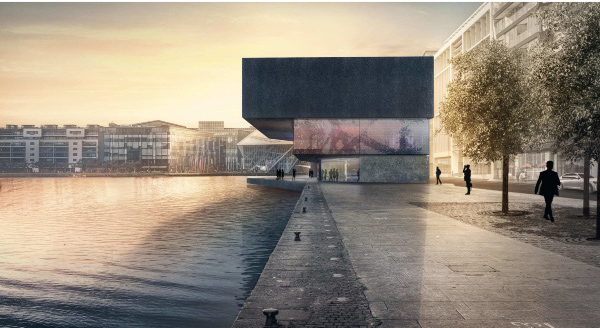
CGI image of the approved U2 Visitor Centre on Hanover Quay, Grand Canal Dock. Directly behind from this angle was Harry Crosbie’s proposed hotel, which was refused permission by the City Council. Image: ODAA architects / DublinCity Council Planning Department.
By Alexander Kearney
No sleight of hand, but a twist of fate means that U2 have finally been granted permission for a Visitor Centre on Nos 15 -18 Hanover Quay, while their neighbour and former business partner, Harry Crosbie has been turned down for a boutique hotel project on the adjoining site.
Both applicants submitted their proposals within days of each other last June, but were asked for further information on their respective applications in August. The Planning Authority urged them to coordinate more closely, and regretted that a proposed terrace/walkway for the U2 Centre, “feels… like a lost opportunity to connect with the adjoining proposed redevelopment at No 9 Hanover Quay.”
The challenges facing the U2 Visitor Centre were formidable. The application drew ten objections, including one from the management company CLG, who argued on behalf of 63 residents at 5-7 Hanover Quay, that it “will create significant amenity issues for adjoining properties, including overshadowing of apartments.” The Planning Authority stated it had “serious concerns” regarding the height of the proposed 14.4m tall building, and requested that the second floor façade treatment be reconsidered so that it “does not overbear or have a detrimental visual impact for future neighbouring residents.”
Architects for the project, ODAA, succeeded in lowering the roof line by 2.34m, and shifted around the façade elements. The planner found the new elevation “less uncompromising”.
Another success of the amended design was deemed to be its treatment of ground floor circulation and quay front access; this was previously criticised for its lack of ‘permeability’. A new external access route will cut through the West side of the building and give direct public access to a proposed pontoon, which will also be approached from the pier-side to the East.
Indeed, the reduced height of the Visitor Centre is made to align precisely with the top of Crosbie’s proposed four-star hotel. The dramatic projecting upper stories of the U2 building now angle in at the West end, as if to defer to their neighbour.
Yet deference was not a quality that distinguished Harry Crosbie’s letter, included in the applicant’s response, justifying his opposition to opening his quayside to the general public, and to the Visitor Centre. In it he bluntly declares, “If D.C.C insists on an open quayside, then I would prefer to abandon the project and stay as we are now.”
Elsewhere in the letter, he draws a sharp distinction between the business profiles of his intended 19 room hotel and the Visitor Centre. “The U2 experience will attract large crowds of tourists who will queue for long periods if needed… We, however, are opening a boutique hotel with guest bars and dining areas… It would be impossible to run a business with huge crowds of young people regularly sunbathing right up against our windows, as now regularly happens around the basin on summer days. We have no problem with people using the quayside provided they enter through the main doors and we can control the numbers and the behaviour.”
While the contrast is emphasised, he concludes, “Both of the businesses working together will enhance and uplift the whole area and will be enjoyed for many years to come.” He adds, “I hope my long experience in the area and with U2 will be taken as solid advice.”
It was not. Though the final planner’s report acknowledges, “that a sensitive and appropriate redevelopment of the subject site may be welcomed in the future, the Applicant has failed in this instance to address the issues and concerns expressed in the Additional Information Request…”
It goes on to state that, “The proposal does not sufficiently comply with SDZ Objective 5.5.21, maximising public pedestrian access to all water bodies and fails to sensitively reuse and redevelop the existing historic structures on site.” An added complication for Crosbie was that his property, which also serves as his home, is a protected structure. The report found that the proposed scheme “does not relate sensitively to the architectural detail, form and character of the original structure….”
The Planning Authority’s decision to refuse permission was made on the 25th January, just a week after it gave the go-ahead to the Visitor Centre on the 18th. Since both properties lie within a Strategic Development Zone (SDZ), neither decision can be appealed to An Bord Pleanála.
Could it be that Mr Crosbie’s dream of a hotel directly on the quay front may now never be realised unless he accedes to the Council’s wishes?
For U2, their long association with the area looks set to culminate in a permanent attraction for an estimated 390,000 visitors a year.
Whether there’s a further twist in this tale of two neighbours remains to be seen.



